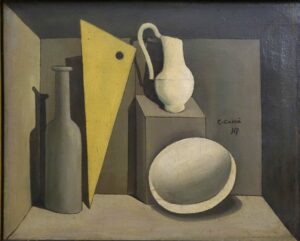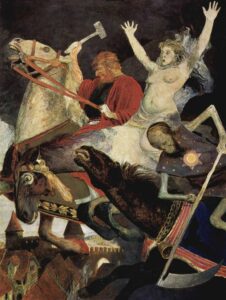Metaphysical painting is an enigmatic art form that captures scenes beyond the physical world.
It’s a visual riddle that intertwines reality with the surreal, inviting us to explore the mysteries that lie beneath the surface of the everyday.
In this article, we’ll jump into the origins and characteristics of metaphysical painting, and why it’s captivated audiences for over a century.
Stay with us as we uncover the allure of this fascinating artistic movement.
Origins Of Metaphysical Painting
Metaphysical painting emerged in the early 20th century, born from the inquisitive mind of Italian artist Giorgio de Chirico.
While studying in Munich, de Chirico was inspired by the philosophical works of Nietzsche and Schopenhauer.
This intellectual backdrop was instrumental in shaping the enigmatic and dream-like qualities that came to define this art movement.
In Florence, de Chirico met fellow artist Carlo Carrà, and together they laid the foundation for what would become metaphysical painting.
Their collaboration proved to be a fusion of talent and ideas, furthering the exploration into the uncanny and the surreal.
Key Artworks and Artists:
- The Enigma of an Autumn Afternoon – the painting by de Chirico that catalyzed the metaphysical art movement,
- The Disquieting Muses – another significant de Chirico piece, full of haunting spaces and mysterious figures,
- Carlo Carrà’s contributions – helped solidify the movement with works like The Enigma of a Day.
The First World War served as a catalyst, with the turmoil and uncertainty of the era seeping into the canvas.
The metaphysical movement sought to illustrate the world beyond the visible, a quest for meaning amidst chaos.

The paintings often featured deserted piazzas, elongated shadows, and a combination of classical and industrial imagery, encapsulating a world in transition.
Characteristics Of Metaphysical Painting
Metaphysical painting defies easy categorization but its unique features are not difficult to recognize.

At the heart of this movement lies a series of recurrent traits that set the genre apart.
We’ll jump into the core aspects that define the essence of metaphysical art.
Moving through stark, dreamlike spaces, metaphysical paintings are known for their enigmatic quality.
The scenery often consists of long shadows and empty squares that evoke a sense of mystery.
Piazza d’Italia by Giorgio de Chirico embodies this with its sharp contrasts of light and architecture that create a haunting atmosphere.
Key elements present in metaphysical works include:
- Unconventional perspectives that disrupt spatial logic,
- Juxtaposition of antiquity with modernity,
- Stark light and shadow play,
- Mannequins and statues that suggest a halted life,
- Placement of everyday objects in unexpected contexts.
The metaphysical approach to everyday objects is particularly intriguing.
Items like gloved hands, artichokes, and trains are depicted in unusual settings or combinations that imbue them with new, often unsettling meanings.
This tactic aligns closely with what would later be determined as Surrealist methods, though metaphysical art maintains its distinct style.
Artists like de Chirico used these objects to tell stories obscured by their sheer abnormality, compelling us to ponder the narratives behind the canvas.
Another prime example is The Disquieting Muses where classical figures stand amidst modern industrial structures, blurring the lines between past and present.
It’s clear that metaphysical painting can be understood as more than just odd compositions; these works prompt us to consider the deeper implications of the seemingly irrational.
They challenge viewers to find coherence in apparent chaos, effectively capturing the floating world of sentiments between the visible and the invisible.
Through metaphysical art, we’re invited to explore the profound spaces of the human psyche, which always promises more questions than it answers.
Influential Artists In The Metaphysical Painting Movement
De Chirico is often cited as the founding father of Metaphysical Painting.
His early works like The Enigma of the Oracle and The Soothsayer’s Recompense embody the quintessential characteristics of the movement – mysterious, eerie townsquares, elongated shadows, and a haunting, timeless atmosphere that seems to suspend reality.
Carrà is another pivotal figure in Metaphysical Painting.
After collaborating with De Chirico during World War I, Carrà’s works like The Gentle Afternoon took on a similar otherworldly quality.
His contributions help solidify the movement’s focus on the dreamlike interaction of objects and their spaces.
The impact of Metaphysical Painting extended beyond Italy, influencing other artists and movements, such as:
- Surrealism – with figures like Salvador Dali and René Magritte drawing heavily from the metaphysical narrative.
- Magical Realism – where the familiar is often skewed by an otherness, permeating the art with a subtle mystique.
Within the context of filmmaking, the tenets of Metaphysical Painting remind us of the power of setting and the importance of visual storytelling.
The ability to create dense, thought-provoking atmospheres without leaning solely on dialogue or action is particularly resonant.
Filmmakers may draw from this style to craft scenes that linger in viewers’ minds, much like the enigmatic cityscapes of De Chirico.
The Influence Of Metaphysical Painting On Modern Art
The ripples of metaphysical painting extended far beyond its inception, influencing a plethora of modern art movements.
Perhaps most notably, Surrealism drew deeply from the metaphysical depiction of dreamlike scenarios and the uncanny.
Artists like Salvador Dalí took cues from the illogical spaces in metaphysical works, blending them with his own explorations of the subconscious mind.
Within the sphere of Magical Realism, writers and visual artists alike drew upon the techniques of metaphysical art to blend the real with the fantastical.
The sharp contrasts of light and shadow and the subtle distortions of perspective found in paintings like De Chirico’s The Song of Love resonated with authors such as Gabriel García Márquez, whose narratives weave the mundane with the extraordinary.

- Influence on Theater and Set Design – – Shaping the visual narrative through meticulous set design – Utilizing stark lighting to enhance emotional impact – Employing unexpected object placement to echo metaphysical themes.
As filmmakers, we can’t help but recognize the movement’s impact on visual storytelling.
The meticulous arrangements of objects and the enigmatic urban landscapes constructed in metaphysical paintings continue to inspire production designers and directors.
Movies like The Grand Budapest Hotel and Pan’s Labyrinth echo the movement’s aesthetic, using setting and visual composition to tell stories that are both grounded in reality and steeped in otherworldliness.
In the world of photography, the influence of metaphysical painting becomes evident in staged shots where photographers, following the movement’s cues, play with perception and juxtapose disparate elements to provoke thought.
While we primarily focus on filmmaking, it’s important to acknowledge how these artistic principles cross over into other creative fields.
Metaphysical art’s significance also percolates through advertising, where the unexpected combination of images can create a memorable and powerful message.
The lure of the strange and the uncanny, hallmarks of metaphysical painting, remain potent tools in capturing the viewer’s attention and conveying complex concepts in a single, arresting image.
What Is Metaphysical Painting – Wrap Up
We’ve seen how metaphysical painting’s legacy continues to ripple through the art world, inspiring a wealth of creative expression across various mediums.
Its influence is undeniable, shaping how we interpret the surreal and the mysterious in visual narratives.
Metaphysical art’s unique ability to capture the imagination and provoke thought ensures its place in the annals of art history.
As we move forward, it’s clear that the echoes of this fascinating movement will persist, challenging and enchanting future generations of artists and audiences alike.
Frequently Asked Questions
What Is Metaphysical Painting?
Metaphysical painting is an artistic style that began in the early 20th century, characterized by illogical space, dreamlike scenarios, and eerily still urban landscapes that create a sense of mystery and contemplation.
How Did Metaphysical Painting Influence Modern Art?
Metaphysical painting has significantly influenced modern art movements, including Surrealism and Magical Realism, inspiring artists to explore dreamlike imagery and irrational spaces within their works.
Can You Name An Artist Influenced By Metaphysical Painting?
One prominent artist influenced by metaphysical painting is Salvador Dalí, known for his Surrealist works that incorporate bizarre dreamscapes and fantastical imagery.
What Impact Did Metaphysical Painting Have On Other Creative Fields?
Metaphysical painting has impacted other creative fields like theater, set design, filmmaking, photography, and advertising by inspiring the use of meticulous set design, stark lighting, and enigmatic storytelling.
Why Is Metaphysical Art Significant In Today’s Culture?
Metaphysical art remains significant today for its ability to capture the viewer’s attention and convey complex concepts through its enigmatic and thought-provoking visual narratives.


